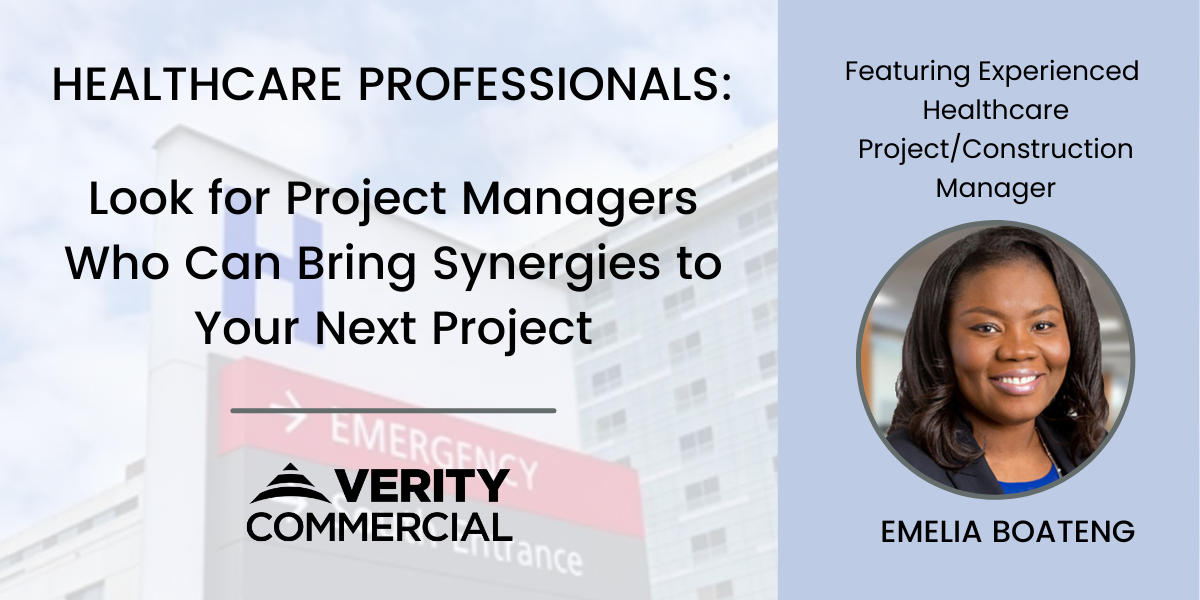Healthcare Professionals: Look for Project Managers Who Can Bring Synergies to Your Next Project

When it comes to healthcare construction projects, synergies are essential. So says Verity Commercial’s Emelia Boateng: “A successful healthcare project demands synergies among trained and invested professionals serving the client.”
But the alignment of interests goes far beyond that. “In the highly specialized and complex construction of healthcare facilities,” she says, “it’s vital that all team members understand not just the complexities of the project at hand but are also sensitive to the culture of the client healthcare organization.”
That understanding lays the groundwork for success, says Boateng, who has more than 10 years of experience in healthcare construction. But it all begins in preplanning, with a solid baseline mapping of schedule, budget, quality and safety.
“We always set up a baseline schedule,” she says, “and over the course of the project, we keep aligning the schedule against the work done to ensure we’re constantly on track.” Areas of discrepancy are thus identified quickly and rectified by examining such possibilities as overtime work, alternate manufacturers for equipment and / or materials (if as a result of procurement issues) and the need for additional worker bench strength.
It helps, of course, that, while the client is the expert on healthcare equipment needs, the Project Manager together with the GC team are responsible for coordinating the procurement and delivery of all parts and ensuring their complete delivery with the client’s healthcare equipment supplier. This includes tight coordination and management of the process and streamlining any supply chain issues all the while.
It helps as well when the team can respond rapidly to unforeseen events, such as spills and leaks, potential hazards that could cause injury in the short term and the growth of mold in the long term. “We always work with a map of shut-off valves as well as lists of contacts for events such as this that can happen overnight,” Boateng states. (She adds that the existence of as-builts to identify existing electrical, HVAC and plumbing connections are a must for all projects in an existing hospital facility.)
The same degree of detail is applied to the all-important budget. “We typically include contingency for both the General Contractor (depending on the contract type) and the Owner,” she explains. Discrepancies here could be the result of such unanticipated issues as a design change or unforeseen conditions in renovations of existing facilities. Then, the hunt is on to recoup capital from somewhere else in the project plan.
Foresight is the key attribute of a great project manager. The ability to identify risks before they become a potential schedule, cost or quality issue on the project is essential.
The project manager is the watchdog of such adjustments, just as she/he is the guardian of overall project quality. That expertise comes into high focus during the installation of the above-mentioned hospital equipment. The demanding installation of such precise and complex equipment is, of course, left to the manufacturers’ expertise. But it falls to the GC and team to ensure the accurate placement of all connecting utilities. They are also responsible for the efficient creation of the framework–the dunnage–that will properly support the machinery.
Breathe Easy
Of course, no project can boast of quality without keeping the safety of the end-user staff, patients, and construction team top-of-mind. Here a project manager with a proven track record is essential.
Toward that end, one critical safety measure is the use of Infection Control Risk Assessment (ICRA) barriers around the project, featuring high-efficiency particulate air (HEPA) filtration to maintain a negative flow of air around the project perimeter. The careful control of airflow protects both hospital staff and patients from potentially harmful construction dust while simultaneously guarding the project team from any airborne bacteria.
The Softer Side of Success
Boateng mentioned the importance of understanding the culture and needs of the client. “This is accomplished through regular meetings with the client,” she says, “well before the project begins and throughout the construction process, typically once a week.”
From hospital vice presidents and physician and nursing staffs to technicians, the multiple stakeholders in a typical healthcare construction project have a say in the project goals. It falls, of course, to the team leaders on both the client and the project side to coordinate that input, says Boateng.
“Frankly, too many people can prolong meetings and potentially slow the process,” she says. “It’s the project manager’s job to bridge any communications gap and keep the project on track. It’s our job to insert ourselves into the culture of the client organization.” It takes tact, she adds, and a sensitive treatment of disparate points of view.
This, to a great extent, is the result of experience. Of course, a proven track record is key to understanding the complexities of a build. For that reason, clients should seek construction veterans with specific healthcare construction certifications.
“But equally important is the experience that brings an understanding of the healthcare culture,” says Boateng. “Your project team must understand what exactly it takes to build a project of this magnitude and complexity. But they also need to understand how their clients work and think.
“Remember,” she concludes, “a successful healthcare construction project is a matter of synergies.”
Connect with Emelia and the Verity team to learn more about healthcare construction management synergies, methods, and best practices.
# # #
Comments